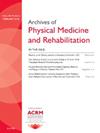Virtual Assessment Protocols for Timed-Up-and-Go, 5-Repetition Chair Rise, and 1-Minute Sit-to-Stand Tests in Community-Dwelling Older Adults: Investigating Feasibility, Reliability, and Validity
IF 3.6
2区 医学
Q1 REHABILITATION
Archives of physical medicine and rehabilitation
Pub Date : 2025-06-01
DOI:10.1016/j.apmr.2024.11.011
引用次数: 0
Abstract
Objective
To develop and evaluate virtual assessment protocols for the Timed-Up-and-Go usual and fast pace, Chair Rise-5 repetition, and the 1-minute Sit-to-Stand tests and examine their feasibility, reliability, and validity.
Design
This was a prospective cohort study, where participants engaged in up to 2 virtual assessments and data were collected prospectively for 1 year.
Setting
Assessments took place in participants’ homes in the community. Toolkits were delivered that included the required equipment and internet-enabled tablet.
Participants
Participants included a random sample of adults ≥65 years old who could walk 10 m without assistance from another person and communicate in English.
Main Outcome Measures
Falls and health care utilization data were collected for 1 year after initial assessments. Descriptive data were used to examine feasibility; intraclass correlation (ICC), and Pearson's/Spearman's correlation and areas under the curve (AUCs) were used to evaluate reliability and validity, respectively.
Results
Sixty participants (mean age 76.6±5.6; 55% female) completed visit 1 and 52 completed visit 2. Technology issues were relatively common, yet no safety incidents occurred. All the virtual mobility tests demonstrated excellent test-retest (ICCs=0.86-0.95) and inter-rater (ICC=0.98-0.99) reliability. The tests had weak-to-moderate correlations with measures of physical function (r=–0.14 to –0.43) and physical activity (r=–0.19 to 0.32). Fifty-seven total falls were recorded by 28 participants (46%) over 1 year. The virtual mobility tests did not have adequate accuracy for predicting falls (AUCs=0.53-0.59), specialist (AUCs=0.48-0.60), family doctor (AUCs=0.48-0.59), or rehabilitation professional visits (AUCs=0.65-0.67), or hospitalizations (AUCs=0.56-0.63).
Conclusion
Results support the feasibility and reliability of virtual administration of the Timed-Up-and-Go usual and fast pace, Chair Rise-5 repitition, and 1-minute Sit-to-Stand tests. Clinicians and researchers can use the included manuals to conduct these tests virtually. Future research should examine the clinical utility of these tests for remote monitoring and mobility assessment.
在社区居住的老年人中进行定时起-走、5次椅子上升和1分钟坐-站测试的虚拟评估方案:调查可行性、可靠性和有效性。
目的:1)制定和评估定时起跳(TUG)常规和快节奏、椅子起身-5重复和1分钟坐立(1MSTS)测试的虚拟评估方案,2)检验其可行性、信度和效度。设计:这是一项前瞻性队列研究,参与者参与了多达两次虚拟评估,并前瞻性地收集了一年的数据。环境:评估在社区参与者的家中进行。提供的工具包包括所需的设备和可上网的平板电脑。参与者:参与者随机纳入≥65岁的成年人,他们可以在没有他人帮助的情况下行走10米,并能用英语交流。主要结果测量:在初步评估后的一年内收集跌倒和医疗保健利用数据。使用描述性数据来检验可行性;采用类内相关、Pearson /Spearman相关和auc分别评价信度和效度。结果:60例受试者(平均年龄76.6±5.6岁;(53%女性)完成了第一次访问,52人完成了第二次访问。技术问题相对普遍,但没有发生安全事故。所有虚拟迁移率测试均表现出良好的重测信度(ICC= 0.86 ~ 0.95)和评估间信度(ICC=0.98 ~ 0.99)。这些测试与身体机能(r=-0.14至-0.43)和身体活动(r=-0.19至0.32)的测量有弱到中度的相关性。28名参与者(46%)在一年内共记录了57次跌倒。虚拟活动能力测试在预测跌倒(AUCs = 0.53 ~ 0.59)、专科医生(AUCs=0.48 ~ 0.60)、家庭医生(AUCs=0.48 ~ 0.59)、康复专业人员就诊(AUCs=0.65 ~ 0.67)或住院(AUCs=0.56 ~ 0.63)方面没有足够的准确性。结论:结果支持了虚拟给药的可行性和可靠性,如TUG常规和快节奏、Chair Rise和1MSTS。临床医生和研究人员可以使用附带的手册进行这些虚拟测试。未来的研究应该检查这些测试在远程监测和移动评估中的临床应用。
本文章由计算机程序翻译,如有差异,请以英文原文为准。
求助全文
约1分钟内获得全文
求助全文
来源期刊
CiteScore
6.20
自引率
4.70%
发文量
495
审稿时长
38 days
期刊介绍:
The Archives of Physical Medicine and Rehabilitation publishes original, peer-reviewed research and clinical reports on important trends and developments in physical medicine and rehabilitation and related fields. This international journal brings researchers and clinicians authoritative information on the therapeutic utilization of physical, behavioral and pharmaceutical agents in providing comprehensive care for individuals with chronic illness and disabilities.
Archives began publication in 1920, publishes monthly, and is the official journal of the American Congress of Rehabilitation Medicine. Its papers are cited more often than any other rehabilitation journal.

 求助内容:
求助内容: 应助结果提醒方式:
应助结果提醒方式:


